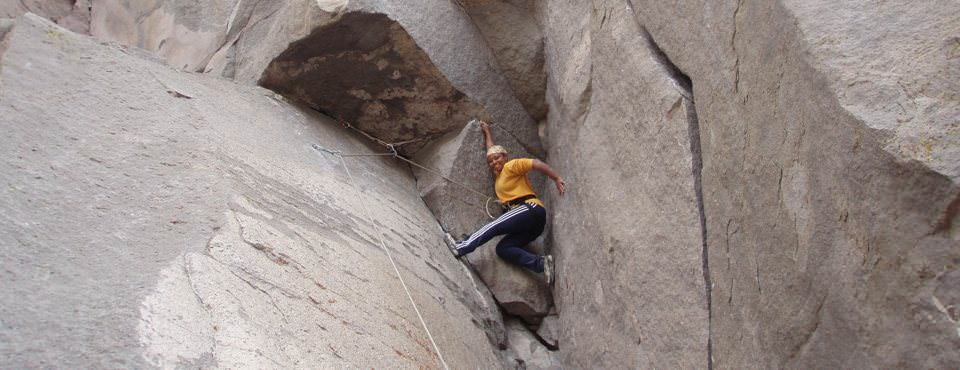Climbing
Climbing is the activity of using one’s hands and feet (or indeed any other part of the body) to ascend a steep object. It is done both for recreation (to reach an inaccessible place, or for its own enjoyment) and professionally, as part of activities such as maintenance of a structure, or military operations. Climbing can be done in the outside world or inside via man-made structures. When climbing outside, knowing how to self-rescue is a must.
Climbing activities include:
- Bouldering: Ascending boulders or small outcrops, often with climbing shoes and a chalk bag or bucket. Usually, instead of using a safety rope from above, injury is avoided using a crash pad and a human spotter (to direct a falling climber on to the pad).
- Buildering: Climbing urban structures – usually without equipment – avoiding normal means of ascent, like stairs,escalators, and elevators. Aspects of buildering can be seen in the art of movement known as Parkour.
- Canyoning: Climbing along canyons for sport or recreation.
- Chalk climbing: cliffs of chalk may (with difficulty) be climbed using some of the same techniques as ice climbing [1].
- Competition Climbing: A formal, competitive sport of recent origins, normally practiced on artificial walls that resemble natural rock formations. The International Federation of Sport Climbing (IFSC) is the official organization governing competition climbing worldwide and is recognized by the IOC and GAISF and is a member of the International World Games Association (IWGA). Competition Climbing has three major disciplines: Lead, Bouldering and Speed.
- Ice climbing: Ascending ice or hard snow formations using special equipment designed for the purpose, usually ice axesand crampons. Techniques of protecting the climber are similar to those of rock climbing, although the protective devices themselves are different (ice screws, snow wedges).
- Indoor climbing: Climbing gyms are indoor climbing facilities where people boulder, top rope, and/or lead climb using plastic holds the screw into a wall generally constructed of wood and mounted to a metal frame. The holds are attached using bolts.
- Lead climbing (also known as “Sport” Climbing, see below): An important form of recreational climbing in which the climber starts at the base of a route, then climbs upwards pulling a rope behind him for protection (i.e. without the benefit of a rope from above). From time to time the rope is passed through a carabiner attached to the rock via some kind of anchor (known as a running belay, or runner), thus affording the climber some degree of protection should he/she fall. The degree of safety depends crucially on the quality of the anchors available, and the distance between them. A falling climber will typically fall over twice the distance between him/her and the last runner.
- Mountain climbing (Mountaineering): Ascending mountains for sport or recreation. It often involves rock and/or ice climbing.
- Net climbing: Climbing net structures. The climbing structures consist of multiple interconnected steel reinforced ropes attached to the ground and steel poles. Climbing nets are usually installed on playgrounds to assist children in developing their balancing and climbing skills.
- Pole climbing (gymnastic): Climbing poles and masts without equipment.
- Lumberjack tree-trimming and competitive tree-trunk or pole climbing for speed using spikes and belts.
- Rock climbing: Ascending rock formations, often using climbing shoes and a chalk bag. Equipment such as ropes, bolts, nuts, hexes and camming devices are normally employed, either as a safeguard or for artificial aid.
- Rope access: Industrial climbing, usually abseiling, as an alternative to scaffolding for short works on exposed structures.
- Rope climbing: Climbing a short, thick rope for speed. Not to be confused with roped climbing, as in rock or ice climbing.
- Scrambling which includes easy rock climbing, and is considered part of hillwalking.
- Sport climbing is a form of rock climbing that relies on permanent anchors fixed to the rock, and possibly bolts, forprotection, (in contrast with traditional climbing, where the rock is typically devoid of fixed anchors and bolts, and where climbers must place removable protection as they climb).
- Top Rope climbing: One common form of climbing is known as top roping. Top rope climbing is the act of climbing a route with a rope attached to the climber, anchored at the top of the route via webbing, and attached to a belayer either on the ground or at the top of the route. The climber ascends the route, all the while safely protected from above in case of a fall.
- Traditional climbing (more casually known as Trad climbing) is a form of climbing without fixed anchors and bolts. Climbers place removable protection such as camming devices, nuts, and other passive and active protection that holds the rope to the rock (via the use of carabiners and webbing/slings) in the event of a fall and/or when weighted by a climber.
- Tree climbing: Ascending trees without the intention of harming them, using ropes and other equipment. This is a less competitive activity than rock climbing.



